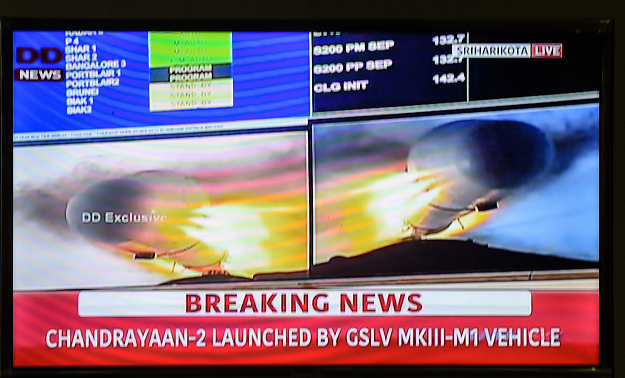India launches historic bid to put spacecraft on Moon
A week after a fuel leak forced a previous attempt to be scrubbed

A television grab shows the launch of Chandrayaan - Moon Chariot 2 at the Satish Dhawan Space Centre in Sriharikota, an island off the coast of southern Andhra Pradesh state, in New Delhi on July 22, 2019. PHOTO: AFP
Chandrayaan-2 - or Moon Chariot 2 - took off on time at 2:43 pm (0913 GMT) from the Satish Dhawan Space Centre on an island off the coast of Andhra Pradesh state.
Applause broke out in the mission control room as the rocket blasted off into the grey skies over the Indian Ocean and mission control announced that the orbiter had broken away from the rocket with no problem.
India counts down to new bid to launch Moon mission
"Today is a historic day for space, science and tech in India," Indian Space Research Organisation (ISRO) chief K Sivan said.
The launch came a week after a fuel leak forced a previous attempt to be scrubbed 56 minutes before the scheduled blast-off.
The South Asian nation is bidding to follow Russia, the United States and China in landing a spacecraft on the Moon.
President Ram Nath Kovind watched the launch alongside 7,000 dignitaries and flag-waving children.
The rocket carried an orbiter, a lander and a rover, and has been almost entirely designed and made in India.
The 2.4-tonne (5,300-pound) orbiter is expected to circle the Moon for about a year, taking images of the surface, looking for signs of water, and studying the atmosphere.
 A television grab shows the launch of Chandrayaan - Moon Chariot 2 at the Satish Dhawan Space Centre in Sriharikota, an island off the coast of southern Andhra Pradesh state, in New Delhi on July 22, 2019. PHOTO: AFP
A television grab shows the launch of Chandrayaan - Moon Chariot 2 at the Satish Dhawan Space Centre in Sriharikota, an island off the coast of southern Andhra Pradesh state, in New Delhi on July 22, 2019. PHOTO: AFPThe lander - named after Vikram A. Sarabhai, the father of India's space programme - will carry the rover and be placed on the surface near the lunar South Pole. The operation is expected to take place in early September.
ISRO scientists will remotely control the rover named Pragyaan - "wisdom" in Sanskrit - as it carries out experiments. It will work for one lunar day, the equivalent of 14 Earth days, studying rocks and soil on the Moon's surface.
Former NASA scientist Kumar Krishen said India's space agency should be praised for taking on ambitious projects such Chandrayaan-2.
"We should keep in mind that space exploration is risky as many systems have failed in the past and many lives lost," he told AFP.
Aside from propelling India into the rarefied company of spacefaring nations, Chandrayaan-2 also stands out because of its low cost.
About $140 million has been spent on preparations for the mission, a much smaller price tag compared with similar missions by other countries.
'The world was watching': US commemorates Apollo mission 50 years on
The United States - which is marking the 50th anniversary of Neil Armstrong becoming the first human on the Moon - spent the equivalent of more than $100 billion on its Apollo missions.
Chandrayaan-2, and India's space programme as a whole, are a source of national pride.
Prime Minister Narendra Modi has vowed to send a manned mission into orbit by 2022, and India also hopes to seek out lucrative commercial satellite and orbiting deals.
The new mission comes almost 11 years after the launch of India's first lunar mission - Chandrayaan-1 - which orbited the Moon and searched for water.



















COMMENTS
Comments are moderated and generally will be posted if they are on-topic and not abusive.
For more information, please see our Comments FAQ